Dude! Take Your Turn!
A Gaming Life
New to Me – June 2020
It was a month of horror in the Dude Take Your Turn household in June.
Not because of anything bad, and certainly nothing virus-related.
It’s just that 2 of the 4 new games played this month have to do with Ancient Evils trying destroy the world.
And we stopped them.
We stopped them all!
Ok, we cheated a bit on two of them (unintentionally), but still.
We are heroes!
That didn’t stop us from playing the games like this.

But it didn’t matter. We beat them!
We also got a cute little card game in and I rolled some dice.
So without further adieu (all of my adieu rolled off the table and under the couch anyway), let’s begin!
Twice as Clever (2019 – Stronghold Games) – 2 plays

Designer: Wolfgang Warsch
Artist: Leon Schiffer
Players: 1-4
For a long while, all the rage of boardgame Internet was the roll and write game That’s Pretty Clever (I’m not going to even try to type it in German).
I even got in on the fun with the app version, but didn’t play it on the table until January.
When it came time to buy some games to play at home during quarantine, though, the sequel dice game jumped out at me.
Twice as Clever does a lot of the same things the original does, but it adds a bit more complexity.

That’s mainly because of that new silver die that’s been added to the mix (even though I have great issue with it being a silver die, as the scoring region on the sheet really doesn’t jump out at you except by process of elimination…oh, that’s the only one left, it must be silver!)
Just like the original game, Twice as Clever has you rolling dice three times. Each time, you choose a die to then mark of a space on your score pad. Any dice that are lower than the one you chose are put on the platter for others to use and then you roll again.

Lather, rinse, repeat until you’ve done it three times. Then the other players get to choose one of the dice you didn’t pick to score on their sheets.
As I said, there is a bit more complexity, not just in the silver die area but also in a couple of others.

For silver, if you choose the silver than you can mark off any coloured area with that number on the sheet. Then, for every die that you put on the platter, you can also mark off that one. Choose a silver 5 and you place a yellow 4 on the platter? You can mark off the yellow 4 in the silver scoring area.

This gives you a bit more incentive to choose the silver die even if it’s high, though you could then lose out on being able to choose three dice on your turn. But maybe you rolled a silver three on your first roll with a couple of twos? Maybe that would be a good first choice.
The yellow area is also a bit more complicated than the original.
When you choose yellow, you circle the number that you chose. The bonuses are based on yellow numbers you’ve circles. However, the scoring is only based on the yellow numbers you’ve crossed off (which requires a second roll of that number after circling it the first time).
The green choices require you to do a little math, where you will be multiplying the number you place in the section by whatever multiplier is there. However, each pair of green entries will score the first number minus the second number. So you want that first number to be high and that second number to be low.
While it’s not that complicated, it is definitely about twice as complicated as the original game.
Twice as clever?
I don’t know about that.
I do know that it’s a fun game, even though I have only played it solo.
I tried teaching it to my wife and for whatever reason I just have trouble explaining this game well. I keep getting tongue-tied and unclear and it just hasn’t worked.
Maybe one day I’ll get it clear in my head and be able to teach it.
In the meantime, it is a fun solo game, and I’m definitely glad I picked it up.
Elder Sign (2011 – Fantasy Flight Games) – 2 plays

Designers: Richard Launius, Kevin Wilson
Artist: Dallas Mehlhoff
Players: 1-8
Elder Sign is kind of Arkham Horror: the Dice Game.
It’s amazing how all of these various Arkham games have such similarities but yet are so different. They have the same investigators (depending on which expansions you have, of course), they have the same Old Ones that you are facing off against.
Yet they all play so different that they can be played on the same day and you have a different kind of fun!
In Elder Sign, you are in the Arkham Library and you discover that some Old One is trying to break through the barrier between worlds in order to destroy us all.
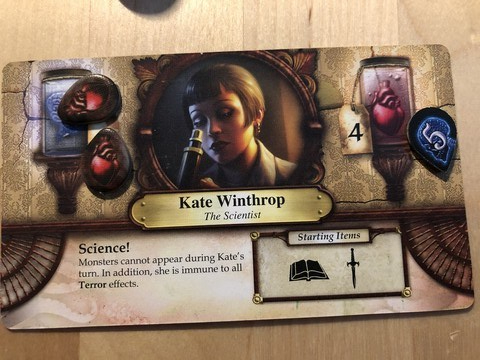
Each player is an investigator with their own ability that will help them in their quest to stave off total annihilation. Kate Winthrop, above, cannot have monsters appear on her turn (very handy!) and also is immune to Terror effects (also quite handy!).

There are six rooms in the library open at any one time, and on your turn you will have your investigator go to one of them.
You’ll have a set of green dice and may have equipment that will give you a better yellow die as well, and possibly even an even better red die too!
The symbols on the room tell you what you need to roll in order to “solve” the room. You can solve only one line per roll, and you set aside the dice that let you do that (so for the Loading Dock in the center above, you could roll a skull or a skull and 3 clues and solve a line).
On the bottom, the white area tells you what you earn if you succeed and the red area is what you lose (or what happens) if you fail.
Each time you roll, if you don’t solve a line, you have to remove one die and then roll again. You can save one die (keeping the same symbol, be it a skull, scroll, terror, or some clues) and that can be used on future rolls to solve a line.
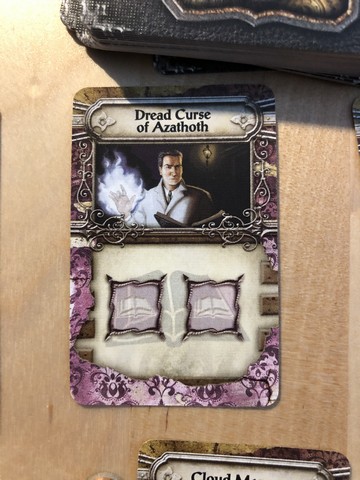
You also may have a spell which will let you save a die for later as well. If you end up not using the die saved on the spell, you can keep the die there and anybody can use it on their turn.
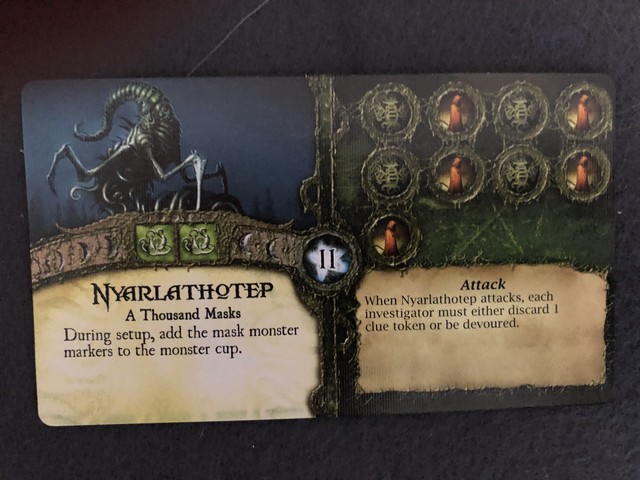
The Old One that you chose to fight will tell you how many Elder Signs (that weird looking symbol) you need to defeat it in total.
The clock starts at Midnight and each player’s turn moves the clock one quarter time ahead (don’t use this game as a tutorial for your children on how to tell time).
Each time the clock strikes Midnight (so basically 4 turns), something bad may happen. Previously you drew a Mythos card and now you resolve the bottom effect if there is a Midnight one, as well as any Midnight effects on rooms that you haven’t solved.

Then you draw a new Mythos card and activate the top of the card. The bottom will remain in effect until Midnight hits again (if it has an ongoing effect).
If the Old One’s Doom track fills up, it’s coming through! You have one last chance to fight it off, but it’s an almost impossible task. You’re probably going to lose.
I really enjoy Elder Sign and even better, my wife enjoys it. There’s something about rolling dice and trying to get the right symbols that’s just appealing. There are ways to mitigate the dice sometimes.
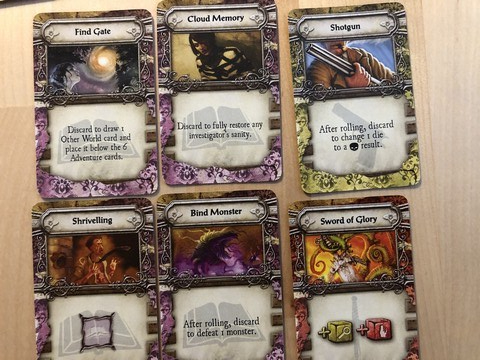
You may have a spell or item that will let you do it, or you can use a Clue that you’ve earned to reroll as many of the dice as you want.
So far, we’ve faced off against the two easiest monsters so we’ve won the game, but we are generally increasing the difficulty so we’ll see how things go in the future.
I’ve also bought three expansions which do expand the world beyond the Arkham Library. It will be interesting to see how those work.
Interestingly enough, there is a really cool iOS (and Google, I assume) app that will let you play solo with up to 4 investigators.
There are a couple of changes to be aware of, though.
First, if the Old One’s Doom track fills up, it’s game over. You don’t get a chance to fight it.
Secondly, saving dice to spells only lasts during your current encounter. That threw me off once because I saved a die figuring I could use it later and then it was nowhere to be found.
I really enjoy the app too, though, and I highly recommend either if you want to face off against Doom and try to win against all odds.
I’m glad I bought this one because it’s a hit with both me and my wife.
Jaipur (2009 – Space Cowboys) – 1 play

Designer: Sébastien Pauchon
Artists: Vincent Dutrait, Alexandre Roche
Players: 2
Jaipur is a 2-player card game where you and your opponent are trying to become the Maharaja’s personal trader. You’re going to be doing this by trying to become the richest trader in six different goods: Diamonds, Gold, Silver, Cloth, Spice, and Leather.

You’re going to be doing that by cleverly taking goods from the market or using your camels and cards in your hand skillfully to build up sets of a good in your hand.
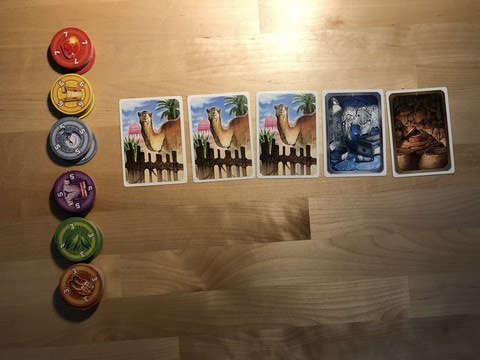
Your turn is simple so the game is really fast. You can either take cards or sell cards.
For taking cards, you either take one good from the market, take all the camels from the market and put them in your herd, exchange 2 or more cards for an equal number of goods in the market. The goods you exchange can be from your hand or you can put camels from your herd in the market instead (if you want to keep more cards in your hand).
Instead of taking, you can sell a set of goods in your hand. The most valuable goods (diamonds, gold, or silver), you have to sell at least two cards. The other three you can sell just one card if you wish.

For each card in the set you sold, you take one goods token of the appropriate type that are stacked next to the market in descending order of value.
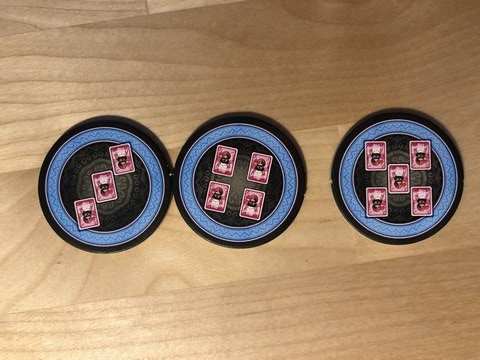
If you sold three, four, or five or more goods in that set, you also take the appropriate bonus token. These are going to be worth bonus rupees.
Once all of the cards are out of the draw pile or three stacks of goods tokens are empty, the round ends.
Whoever has the most camels in their herd gets the 5-rupee Camel bonus token.
Total up your rupees and whoever has the most wins the round!
Then do it again until one player has won twice.
That player wins the game!
This is a cute little game and I did enjoy my plays of it. I can see how it might grow a little stale after a while, but for now I think it was definitely worth a purchase in these quarantine times. It’s nice to have a simple 2-player card game available to play if you just want to pick something up pretty quick.
For a small card game, it does take up a lot of space on the table, though. Unfortunately it’s not a game that you can just pull out a TV tray for and play.
But I do like the decisions you have to make. There are a lot of camels in the market. Is it worth taking them all even though you’re refreshing the market for your opponent? What if they don’t have any camels so they can’t do any major exchange without getting rid of cards in their hand?
It’s not deep game at all but it plays very quickly and our play of it was enjoyable.
We’ll see if it holds up.
Arkham Horror: the Card Game (2016 – Fantasy Flight Games) – 1 play

Designers: Nate French, Matthew Newman
Artists: Lots!
Players: 1-2
And then we get to the big one.
I have said many times that I didn’t want to get into a Living Card Game (LCG) because of the campaign aspect and because you just have to keep buying many expansions and card sets to really get good play value out of them. Sure, the base game comes with a small campaign, but that’s going to get old after a while and all of the surprises are gone.
I resisted and resisted.
And then COVID-19 hit.
It’s no secret that, while I try to play a lot of new to me games, the majority of them I end up playing are brought to game days by other people. I have my fair share, but these posts are mostly generated from games my friends have.
Now that’s not happening. I’m the one that has to provide all the games. In order to keep these “new to me” posts going, as well as to keep my sanity because I still want to play games, I needed to find things that I could play with my wife. And with a ready-made audience where we can play every week, as well as my wife really liking cooperative games, how could the Arkham Horror LCG miss?
So I went ahead and bought it.
And then really loved it (my wife’s not quite sold on it yet).
So much so that I went ahead and bought as much of the next campaign cycle (the Dunwich Legacy) as I could and will buy the remaining two pieces when they become available again.
In the Arkham Horror LCG, players will take on the role of an investigator (the Core set comes with 5 but I think every expansion comes with more.
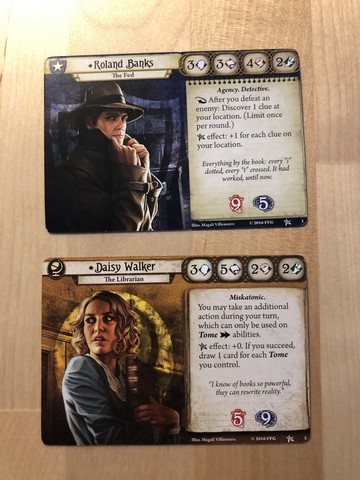
Once you’ve chosen your investigators, you are going to be building a deck of 30 cards plus a couple of cards that are unique to that investigator and which must be included in their decks.
Each investigator has a special ability that will help you in your quest to defeat the forces of evil as they try to enact their wicked agenda.
Your decks are going to have a variety of things in them, from allies to assets to skills to yes, a couple of weaknesses that will make your life that much harder.

You’ll start the scenario with 5 cards and you can “mulligan” those if you get a bunch of crap before you even start.
The campaign booklet will tell you what cards you need to pull to and form into their own decks, as well as what locations you are going to need.
In other words, there is a lot of set up, but isn’t that always the case with these FFG Arkham games? I think Elder Sign is probably the easiest to set up and even that has some card shuffling in it.

During the Investigator Phase, you’ll be doing three actions, which can be a variety of things from playing cards (and paying for them), fighting a monster if there happens to be one where you are, moving from location to location, or even just as simple as gaining a resource or drawing a card.
Once all investigators have gone, the Monster and Upkeep phases happen. If there are Enemies on the table, they attack or move (if able) in the Monster phase. The Upkeep phase has each player draw a card, gain a resource, and reset exhausted cards.
The are two things that are moving forward, one that you want to move forward and one you don’t.
The “Acts” of the scenario are what you are trying to achieve. When you fulfill the requirements of the current Act, it advances and you are that much closer to winning!
The Agenda advances at the beginning of each turn in the Mythos Phase (except for the first turn). You don’t want that to advance as that brings the bad guys closer to winning.
During each Mythos Phase, in addition to a Doom token being put on the Agenda, each investigator is going to draw a card from the Encounter deck, which is usually bad.

Monsters will engage with the investigator that drew them. Other things, like the Treachery cards, require skill checks by that investigator.
The turns keep going from Mythos to Investigation to Monster to Upkeep phases and back again until you reach a Resolution (either on the Act Deck, the Agenda deck, or maybe even one of the rooms).
You then read the appropriate resolution in the Campaign Guide and move on from there.
If you’re doing the Campaign and not just playing the scenario, then you will get experience which you can use to upgrade or replace cards in your deck.
And then it’s on to the next scenario!
So far, we’ve played the first scenario twice. We did it the first time just to see what it was like, and now we have started the campaign.
However, we made an error that made it way too easy for us. The final monster’s health is supposed to be 5 points per investigator, but I was only counting it as 5 health.
But mistakes will happen and we will play this again with other investigators!
So I’m not too unhappy about it.
This game is addicting.
Even though I’m not up to the point of wanting to build my own decks, I am religiously looking at the Arkham Horror LCG Database and checking out decks that others have made, or what each card is like.
My wife said that I’m obsessed with the game, and it’s probably not an inaccurate statement.
And I kind of knew this would happen, which is another reason I was avoiding LCGs like the plague.
But I’m in it now, so we’ll see how I come out of it.
In the meantime, hopefully the wife will grow to at least like it like I love it. She seems amenable to it, and hopefully it will keep going as we’re stuck at home rather than me going out to game days.
But be warned.
If you don’t want to have this happen to you, you should avoid this game (and others like it) like the plague.
I’m living proof that it can happen to you.
So those are the four “new to me” games that I played in June.
What did you get played? Are you able to game with a couple of select friends even with all of the weirdness happening right now?
And what is your Living Card Game opinion?
Let me know what you’ve played in the comments.
I adore H. P. Lovecraft universe. Glad you like it too!
LikeLiked by 1 person
I don’t know about the universe, but I like the games. 🙂
LikeLiked by 1 person
Pingback: Boardgame Geek Top 100 – Played or Play #20-11 – Dude! Take Your Turn!
Pingback: Boardgame Geek Top 200 – Play or Played – #140 – 131 – Dude! Take Your Turn!
Pingback: New to Me – December 2020 – Dude! Take Your Turn!
Pingback: Blog in Review – 2020 – Dude! Take Your Turn!
Pingback: Friday Night Shots – Playing with Non-Gamers? – Dude! Take Your Turn!